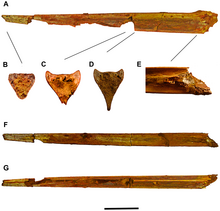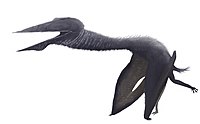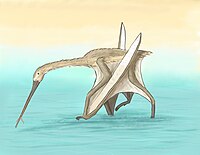| Thalassodromids Temporal range: Early-Late Cretaceous, 112–88 Ma PreꞒ Ꞓ O S D C P T J K Pg N | |
|---|---|

| |
| Replica skeleton of Tupuxuara leonardii | |
| Scientific classification | |
| Domain: | Eukaryota |
| Kingdom: | Animalia |
| Phylum: | Chordata |
| Order: | †Pterosauria |
| Suborder: | †Pterodactyloidea |
| Clade: | †Azhdarchoidea |
| Family: | †Thalassodromidae Witton, 2009 |
| Type species | |
| †Thalassodromeus sethi Kellner & Campos, 2002 | |
| Genera | |
| Synonyms | |
| |
Thalassodromidae (meaning "sea runners", due to previous misconceptions of skimming behavior; they are now thought to be terrestrial predators) is a group of azhdarchoid pterosaurs from the Cretaceous period. Its traditional members come from Brazil, which include the type genus Thalassodromeus, as well as Tupuxuara. Additionally, the recently named genus Kariridraco, also from Brazil, is another undisputed thalassodromid. However, other possible members also come from other places, including Morocco and Argentina.
The classification of Thalassodromidae is quite controversial and disputed. It was actually initially denominated Thalassodrominae, as a subfamily within the group Tapejaridae. However, opposing studies regarding its placement have argued that its members were more closely related to azhdarchids and dsungaripterids, while also elevating it to family level. As of the present day, the denomination Thalassodromidae is preferred in order to maintain naming consistency despite disagreements about classification.
Classification

The classification of thalassodromids is controversial. Its initial members included Thalassodromeus and Tupuxuara, which were assigned initially to the family Tapejaridae by Brazilian paleontologists Alexander Kellner and Diógenes de Almeida Campos. In 2007, the subfamily Thalassodrominae was coined by Kellner to group both members within Tapejaridae. However, several conflicting studies arose. They argued that both Thalassodromeus and Tupuxuara were more closely related to the family Azhdarchidae instead of the tapejarids. As early as 2003, paleontologist David Unwin created the group Neoazhdarchia to contain Tupuxuara and Azhdarchidae. This arrangement would later be supported by British paleontologists David Martill and Darren Naish, who deemed Tapejaridae to be paraphyletic (unnatural), and found both Thalassodromeus and Tupuxuara as sister taxa to Azhdarchidae. In 2008, Chinese paleontologist Lü Junchang and colleagues would use the term "Tupuxuaridae" to include both genera in their phylogenetic analysis, finding the group nested within Neoazhdarchia. In 2009, British paleontologist Mark Witton also concurred with the placement of Thalassodromeus and Tupuxuara within Neoazhdarchia. However, he noted that the term Thalassodrominae was created before Tupuxuaridae, so therefore it had naming priority. He elevated Thalassodrominae to family level to satisfy the hierarchy within Neoazhdarchia, thus creating the denomination Thalassodromidae.
On the other side, Kellner's classification model indicating a tapejarid identity for Thalassodromeus and Tupuxuara would also be supported by numerous studies, such as that of Brazilian paleontologist Felipe Pinheiro and colleagues in 2011, that of paleontologist Rodrigo Pêgas and colleagues in 2018, and that of Kellner and colleagues in 2019. In 2021, paleontologist Gabriela Cerqueira and colleagues named the new genus Kariridraco and found it to group with both Thalassodromeus and Tupuxuara, following a tapejarid identity, thereby using the denomination Thalassodrominae.
The cladogram below shows the phylogenetic analysis by Cerqueira and colleagues in 2021, in which they used Kellner's model of classification. Thalassodrominae would be grouped with the subfamily Tapejarinae within Tapejaridae.
| Tapejaroidea |
| ||||||||||||||||||||||||||||||||||||||||||

In 2018, paleontologist Nicholas Longrich and colleagues recovered the pterosaurs Aerotitan and Alanqa as thalassodromids, but noted that their fossil remains of are fragmentary, so this assignment was only tentative. In a 2021 study, Pêgas and colleagues reassigned Aerotitan back to Azhdarchidae, corrobating its initial placement in its description. Alanqa was assigned to its own family, the Alanqidae, as the sister taxon of Keresdrakon. Alanqidae in turn was recovered as the sister taxon of Azhdarchidae.

 Life reconstructions of the possible thalassodromids Argentinadraco (above) and Leptostomia (below)
Life reconstructions of the possible thalassodromids Argentinadraco (above) and Leptostomia (below)
In the same year, American paleontologist Brian Andres would also find an azhdarchid identity for Aerotitan. However, he found Alanqa as a thalassodromid, following Longrich and colleagues in 2018. He would also find the pterosaurs Argentinadraco, Leptostomia, and Xericeps within Thalassodromidae, expanding the family to six genera, including the traditional members Thalassodromeus and Tupuxuara. He would additionally utilize the term Thalassodrominae as a subfamily within Thalassodromidae in his phylogenetic analysis, in which he would include all thalassodromid genera except for Tupuxuara. This is a new arrangement for the group that has not appeared in any former study, whether in favor of a tapejarid or a neoazhdarchian identity. The results of his study are shown in the first cladogram below. In 2023, Pêgas and colleagues argued that despite the disagreements about the position of the group, the species contained within it have almost always been consistent (Thalassodromeus and Tupuxuara). Therefore, they deemed the difference in naming pattern undesirable. They favored the denomination Thalassodromidae to have consistency with other studies that used the same name. In their phylogenetic analysis, they supported a close relationship between the thalassodromids and the family Tapejaridae, thereby following the classification model established by Kellner. Both Thalassodromidae and Tapejaridae would form the larger group Tapejaromorpha. The results of their study are shown in the second cladogram below. Subsequent studies using Kellner's model would also employ the denomination Thalassodromidae instead of Thalassodrominae.
|
Cladogram based on Andres, 2021:
|
Cladogram based on Pêgas and colleagues, 2023:
|
References
- Kellner, A. W. A.; Campos, D. A. (2007). "Short note on the ingroup relationships of the Tapejaridae (Pterosauria, Pterodactyloidea)". Boletim do Museu Nacional: Geologia. 75: 1–14.
- Unwin, D. M. (2003). "On the phylogeny and evolutionary history of pterosaurs". Geological Society, London, Special Publications. 217 (1): 139–190. Bibcode:2003GSLSP.217..139U. doi:10.1144/GSL.SP.2003.217.01.11. S2CID 86710955.
- Martill, D. M.; Naish, D. (2006). "Cranial crest development in the Azhdarchoid pterosaur Tupuxuara, with a review of the genus and tapejarid monophyly". Palaeontology. 49 (4): 925–941. Bibcode:2006Palgy..49..925M. doi:10.1111/j.1475-4983.2006.00575.x. S2CID 15609202.
- Lü J.; D.M. Unwin; Xu L.; Zhang X. (2008). "A new azhdarchoid pterosaur from the Lower Cretaceous of China and its implications for pterosaur phylogeny and evolution". Naturwissenschaften. 95 (9): 891–7. doi:10.1007/s00114-008-0397-5. PMID 18509616.
- Witton, M. P. (2009). "A new species of Tupuxuara (Thalassodromidae, Azhdarchoidea) from the Lower Cretaceous Santana Formation of Brazil, with a note on the nomenclature of Thalassodromidae". Cretaceous Research. 30 (5): 1293–1300. Bibcode:2009CrRes..30.1293W. doi:10.1016/j.cretres.2009.07.006. S2CID 140174098.
- Pinheiro, F.L., Fortier, D.C., Schultz, C.L., De Andrade, J.A.F.G. and Bantim, R.A.M. (in press). "New information on Tupandactylus imperator, with comments on the relationships of Tapejaridae (Pterosauria)." Acta Palaeontologica Polonica, in press, available online 03 Jan 2011. doi:10.4202/app.2010.0057
- Pêgas, R. V.; Costa, F. R.; Kellner, A. W. A. (2018). "New Information on the osteology and a taxonomic revision of The genus Thalassodromeus (Pterodactyloidea, Tapejaridae, Thalassodrominae)". Journal of Vertebrate Paleontology. 38 (2): e1443273. Bibcode:2018JVPal..38E3273P. doi:10.1080/02724634.2018.1443273. S2CID 90477315.
- Kellner, Alexander W. A.; Weinschütz, Luiz C.; Holgado, Borja; Bantim, Renan A. M.; Sayão, Juliana M. (August 19, 2019). "A new toothless pterosaur (Pterodactyloidea) from Southern Brazil with insights into the paleoecology of a Cretaceous desert". Anais da Academia Brasileira de Ciências. 91 (suppl 2): e20190768. doi:10.1590/0001-3765201920190768. ISSN 0001-3765. PMID 31432888.
- ^ Cerqueira, Gabriela M.; Santos, Mateus; Marks, Maikon; Sayão, Juliana; Pinheiro, Felipe (2021). "A new pterosaur species from the Lower Cretaceous of Brazil and the paleobiogeography of the Tapejaridae (Azhdarchoidea)". Acta Palaeontologica Polonica. 66. doi:10.4202/app.00848.2020.
- Longrich, Nicholas R.; Martill, David M.; Andres, Brian; Penny, David (2018). "Late Maastrichtian pterosaurs from North Africa and mass extinction of Pterosauria at the Cretaceous-Paleogene boundary". PLOS Biology. 16 (3): e2001663. doi:10.1371/journal.pbio.2001663. PMC 5849296. PMID 29534059.
- Pêgas, R.V.; Holgado, B.; Ortiz David, L.D.; Baiano, M.A.; Costa, F.R. (August 21, 2021). "On the pterosaur Aerotitan sudamericanus (Neuquén Basin, Upper Cretaceous of Argentina), with comments on azhdarchoid phylogeny and jaw anatomy". Cretaceous Research. 129: Article 104998. doi:10.1016/j.cretres.2021.104998. ISSN 0195-6671. S2CID 238725853.
- ^ Andres, Brian (December 7, 2021). "Phylogenetic systematics of Quetzalcoatlus Lawson 1975 (Pterodactyloidea: Azhdarchoidea)". Journal of Vertebrate Paleontology. 41 (sup1): 203–217. Bibcode:2021JVPal..41S.203A. doi:10.1080/02724634.2020.1801703. ISSN 0272-4634. S2CID 245078533.
- ^ Pêgas, R. V.; Zhoi, X.; Jin, X.; Wang, K.; Ma, W. (2023). "A taxonomic revision of the Sinopterus complex (Pterosauria, Tapejaridae) from the Early Cretaceous Jehol Biota, with the new genus Huaxiadraco". PeerJ. 11. e14829. doi:10.7717/peerj.14829. PMC 9922500.
- Pêgas, Rodrigo V. (June 10, 2024). "A taxonomic note on the tapejarid pterosaurs from the Pterosaur Graveyard site (Caiuá Group, ?Early Cretaceous of Southern Brazil): evidence for the presence of two species". Historical Biology: 1–22. doi:10.1080/08912963.2024.2355664. ISSN 0891-2963.
- Zhou, Xuanyu; Ikegami, Naoki; Pêgas, Rodrigo V.; Yoshinaga, Toru; Sato, Takahiro; Mukunoki, Toshifumi; Otani, Jun; Kobayashi, Yoshitsugu (November 16, 2024). "Reassessment of an azhdarchid pterosaur specimen from the Mifune Group, Upper Cretaceous of Japan". Cretaceous Research. 167: 106046. doi:10.1016/j.cretres.2024.106046. ISSN 0195-6671.
| Taxon identifiers | |
|---|---|
| Thalassodromidae | |
| Thalassodrominae | |












